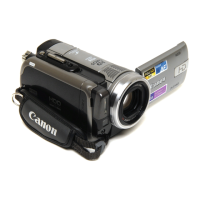Disposal
•
When you delete movies
or
initialize the
hard disk or memory card, only the file
allocation table is altered and stored
data
is
not physically erased. Take the
necessary precautions when you
dispose
of
the camcorder
or
memory
card, for example by physically
damaging it
to
prevent the leakage
of
private data.
If giving the camcorder
to
another
person, initialize the hard disk, fill up the
hard disk with unimportant recordings,
and then initialize the hard disk again.
This makes recovering the original
recordings very difficult.
Condensation
Moving the camcorder rapidly between
hot and cold temperatures may cause
condensation (water droplets)
to
form
on its internal surfaces. Stop using the
camcorder if condensation is detected.
Continued use may damage the
camcorder.
Condensation
may
form
in
the
following
cases:
• When the camcorder is moved from
an
air-conditioned room to a warm,
humid place
• When the camcorder is moved from a
cold place
to
a warm room
• When the camcorder is left in a humid
room
• When a cold room is heated rapidly
10)
To
AVOID
CONDENSATION
• Do not expose the camcorder to
sudden
or
extreme changes in
temperature.
• Place the camcorder in
an
airtight
plastic bag and let it adjust
to
temperature changes slowly before
removing it from the bag.
I
WHEN
CONDENSATION
IS
DETECTED
The camcorder automatically shuts off.
The precise time required for water
droplets to evaporate will vary
depending on the location and weather
conditions. As a general rule, wait for 2
hours before resuming use of the
camcorder.
Using
the
Camcorder
Abroad
Power
Sources
You
can use the compact power
adapter
to
operate the camcorder and
to
charge battery packs
in
any country
with power supply between 100 and
240 V AC, 50/60 Hz. Consult a Canon
Service Center for information on plug
adapters for overseas use.
Playback
on
a
TV
Screen
You
can only play back your recordings
on TVs compatible with the NTSC
system. The NTSC system is used in
the following countries/areas:
American Samoa, Antigua, Aruba,
Bahamas, Barbados, Bermuda, Bolivia,
Canada, Chile, Colombia, Costa Rica,
--------------------------
103
Disposal
•
When you delete movies
or
initialize the
hard disk or memory card, only the file
allocation table is altered and stored
data
is
not physically erased. Take the
necessary precautions when you
dispose
of
the camcorder
or
memory
card, for example by physically
damaging it
to
prevent the leakage
of
private data.
If giving the camcorder
to
another
person, initialize the hard disk, fill up the
hard disk with unimportant recordings,
and then initialize the hard disk again.
This makes recovering the original
recordings very difficult.
Condensation
Moving the camcorder rapidly between
hot and cold temperatures may cause
condensation (water droplets)
to
form
on its internal surfaces. Stop using the
camcorder if condensation is detected.
Continued use may damage the
camcorder.
Condensation
may
form
in
the
following
cases:
• When the camcorder is moved from
an
air-conditioned room to a warm,
humid place
• When the camcorder is moved from a
cold place
to
a warm room
• When the camcorder is left in a humid
room
• When a cold room is heated rapidly
10)
To
AVOID
CONDENSATION
• Do not expose the camcorder to
sudden
or
extreme changes in
temperature.
• Place the camcorder in
an
airtight
plastic bag and let it adjust
to
temperature changes slowly before
removing it from the bag.
I
WHEN
CONDENSATION
IS
DETECTED
The camcorder automatically shuts off.
The precise time required for water
droplets to evaporate will vary
depending on the location and weather
conditions. As a general rule, wait for 2
hours before resuming use of the
camcorder.
Using
the
Camcorder
Abroad
Power
Sources
You
can use the compact power
adapter
to
operate the camcorder and
to
charge battery packs
in
any country
with power supply between 100 and
240 V AC, 50/60 Hz. Consult a Canon
Service Center for information on plug
adapters for overseas use.
Playback
on
a
TV
Screen
You
can only play back your recordings
on TVs compatible with the NTSC
system. The NTSC system is used in
the following countries/areas:
American Samoa, Antigua, Aruba,
Bahamas, Barbados, Bermuda, Bolivia,
Canada, Chile, Colombia, Costa Rica,
--------------------------
103

